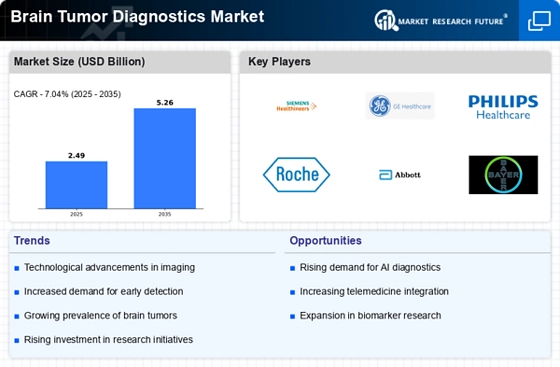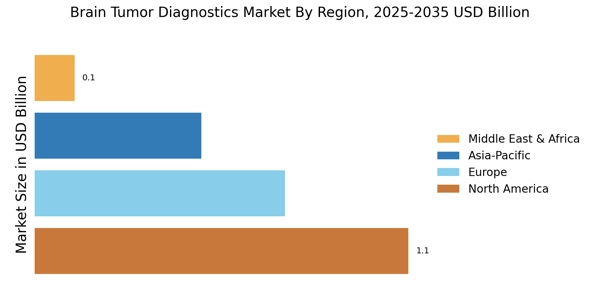Rising Incidence of Brain Tumors
The increasing incidence of brain tumors is a primary driver for the Brain Tumor Diagnostics Market. Recent statistics indicate that brain tumors account for approximately 1.4% of all new cancer cases. This rise in cases necessitates advanced diagnostic tools and technologies to ensure timely and accurate detection. As the population ages, the prevalence of brain tumors is expected to grow, further amplifying the demand for effective diagnostic solutions. The Brain Tumor Diagnostics Market is likely to experience significant growth as healthcare providers seek to implement innovative diagnostic methods to address this rising challenge. Moreover, the need for early diagnosis is critical, as it can substantially improve patient outcomes and survival rates, thereby driving investments in research and development within the industry.
Rising Demand for Personalized Medicine
The growing emphasis on personalized medicine is influencing the Brain Tumor Diagnostics Market. As healthcare shifts towards tailored treatment approaches, there is an increasing need for precise diagnostic tools that can identify specific tumor types and genetic profiles. This demand for personalized diagnostics is driving innovation in the development of targeted therapies and companion diagnostics. The Brain Tumor Diagnostics Market is likely to see a rise in the adoption of diagnostic tests that provide insights into the molecular characteristics of brain tumors. Such advancements not only enhance treatment efficacy but also improve patient management strategies. Consequently, the focus on personalized medicine is expected to propel the growth of the Brain Tumor Diagnostics Market in the coming years.
Increased Research and Development Activities
The surge in research and development activities within the field of oncology is a crucial driver for the Brain Tumor Diagnostics Market. Ongoing studies aim to discover novel biomarkers and develop innovative diagnostic techniques that can enhance the accuracy of brain tumor detection. This focus on R&D is essential, as it leads to the introduction of new diagnostic products and services that cater to the evolving needs of healthcare providers. Furthermore, collaborations between academic institutions and industry players are fostering the development of advanced diagnostic tools. The Brain Tumor Diagnostics Market is expected to expand as these research initiatives yield promising results, ultimately improving diagnostic accuracy and patient outcomes.
Technological Innovations in Diagnostic Tools
Technological advancements in diagnostic tools are transforming the Brain Tumor Diagnostics Market. Innovations such as high-resolution MRI, PET scans, and advanced imaging techniques are enhancing the accuracy of brain tumor detection. These technologies allow for better visualization of tumors, leading to improved diagnostic precision. The market is witnessing a surge in the adoption of these advanced tools, as they facilitate early diagnosis and treatment planning. Furthermore, the integration of machine learning algorithms into imaging technologies is expected to enhance diagnostic capabilities, making it easier for healthcare professionals to identify and classify brain tumors. As a result, the Brain Tumor Diagnostics Market is poised for growth, driven by the continuous evolution of diagnostic technologies that improve patient care.
Growing Investment in Healthcare Infrastructure
The expansion of healthcare infrastructure is a significant driver for the Brain Tumor Diagnostics Market. Governments and private entities are increasingly investing in healthcare facilities, particularly in regions with a high burden of brain tumors. This investment is aimed at enhancing diagnostic capabilities and ensuring access to advanced medical technologies. As healthcare systems evolve, there is a growing emphasis on early detection and treatment of brain tumors, which necessitates the availability of sophisticated diagnostic tools. The Brain Tumor Diagnostics Market stands to benefit from this trend, as improved healthcare infrastructure facilitates the implementation of cutting-edge diagnostic solutions. Additionally, the establishment of specialized centers for brain tumor diagnosis and treatment is likely to further stimulate market growth.


















Leave a Comment